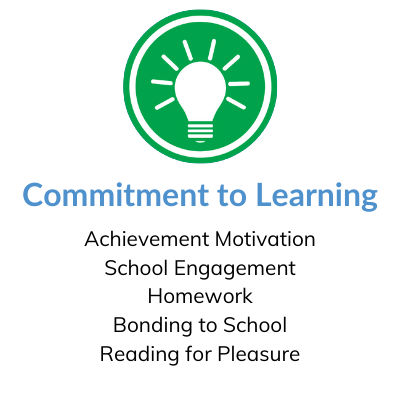Developmental Asset Categories
External Assets: Support | Empowerment | Boundaries & Expectations | Constructive Use of Time
Internal Assets: Commitment to Learning | Positive Values | Social Competencies | Positive Identity
External Assets: Support | Empowerment | Boundaries & Expectations | Constructive Use of Time
Internal Assets: Commitment to Learning | Positive Values | Social Competencies | Positive Identity
Education has improved immensely in the past 20 years. Today, more young people are taking high-level courses, fewer of them are dropping out of school, results in math and science are increasing, and more students are entering college after high school. But that doesn’t mean that a commitment to learning occurs naturally in all young people. Imparting this quality involves a combination of values and skills that include a desire to excel in school, a perpetual sense of the importance of learning, and belief in one’s own abilities. This commitment is strongly influenced by the school environment and relationships with family and peers. Commitment to Learning is one of the eight asset categories that make up Search Institute’s 40 Developmental Assets, the qualities, experiences, and relationships that help young people grow up healthy, caring and responsible.
Research shows that the more young people are committed to learning, the more likely they are to grow up healthy. The Search Institute has identified five key elements in the Commitment to Learning category that are crucial to helping young people: Achievement Motivation, School Engagement, Homework, Bonding to School and Reading for Pleasure.

Share your ideas for building these assets using @ShelteringWings and #SW40Assets.
Young people need a sense of the lasting importance of learning and a belief in their own abilities.
 Do your best and the results will follow.
Do your best and the results will follow.Do you know young people who always try to do their best in school, with no rewards or punishments pending? These students have found a reason to work hard; they are motivated by their achievements. Performing well academically means several things to different people. This does not have to mean that you receive all As or that you are on the honor roll. What this means is doing your best work and that your performance matters to you, whether it’s an art portfolio or writing a composition. There are enough reasons to work hard at school — get good grades, please parents or earn a place on the honor roll. But the greatest incentive for young people to do their best comes from themselves: the personal pride of knowing that they gave their best. Making an effort at school now can give young people more reason to be proud later.
Research shows that young people who try to do their best in school have better grades, are more likely to finish high school and know how to handle stress better. They also set goals better and are more likely to enroll in higher education. About 65 percent of young people, ages 11–18, say they are motivated to do well in school, according to surveys conducted by the Search Institute. Let’s help young people understand how important it is for them to study well, pay attention and do their homework.
What motivates young people you know to do their best? Whatever her reasons, remind her that when she tries to do her best, she can always feel good about the results, no matter what the grade.
In your home and family: Ask your child what motivates him or her to excel in school. Find out what challenges he or she faces and discuss ways to overcome them. Share any tips or suggestions that you learned during your own school experiences.
In your neighborhood and community: When you ask young people how they are doing in school, focus on their interests instead of their grades.
In your school or youth program: Discuss the following with young people: If your school awarded a letter of recognition for participating or excelling in any subject or activity, (e.g., being one of the best members of an athletic team or one of the best students in any subject) what would be yours? Why?
 Academics are important, but there’s more to education.
Academics are important, but there’s more to education.Every day is a new beginning, a new day to learn. For some young people, this prospect is exciting and exhilarating. For others, it is fearful. Sometimes learning is difficult, but that is OK. Young people must understand that academic studies are only part of the education they must complete before they successfully achieve their goals. So find creative ways to show young people that learning means much more than just worrying about tests; learning opportunities are everywhere. . . And they are fun!
Research shows that young people who are actively participating in learning exhibit more positive than negative behaviors. About 55 percent of young people, ages 11–18, say they are actively involved in their learning. It is time to help even more young people discover — and achieve — personal success in and out of the classroom.
The best way to keep young people engaged in school is to focus on their individual goals and interests. So listen to young people and pay attention to the activities that they enjoy the most. Once you are aware of what they want (or needs), help them link their interests and goals to the things they learn in and out of school. Since learning doesn’t just happen within the four walls of the school, look for — or design — additional learning activities that complement the school curriculum. Celebrate school success. Help young people face whatever challenges they encounter.
In your home and family: Help your child stay interested and involved in school by making sure he or she has enough time to sleep, eats well and can face difficulties. Teach your child that learning is more than just the classes they take at school. Talk to your child about things he or she is interested in and help your child find new ways to experiment and learn about those interests — outside of the classroom.
In your neighborhood and community: Find ways to satisfy young people’s curiosity with books, games, artwork and etcetera. At your local library or community center, post notes about fun community events and activities, such as writer’s autographs, school discussions or museum classes.
In your school or youth program: Help young people focus on their personal ideas of success. Do this by having them create goals that encompass academic achievement, hobbies and values. After several weeks, evaluate the students based on their goals. Celebrate successes and talk about ways to change in areas that need improvement.
 Homework – an important part of achieving our goals.
Homework – an important part of achieving our goals.Remember when you were a student and you dreamed of a day without homework? It could be that you loved classes and learning, but you were afraid of tests and homework. Well, you are not alone. Most young people would rather play video games than sit down and read The Great Gatsby or work on statistics. But any goal worth achieving takes a lot of hard work. Work also takes place not only in the classroom, but also at home. In addition to achieving academic goals, doing homework teaches young people how to follow directions, organize their time and work independently.
Research shows that young people who spend at least one hour each weeknight doing homework are more likely to grow up healthy, stay committed to learning and achieve their goals. About 47 percent of young people, ages 11–18, report doing at least one hour of homework each school day, according to surveys conducted by the Search Institute.
It may be that all you hear from young people about homework is that they hate it, have no homework or have a lot of homework the night before the test. But many young people are more likely to lack some essential homework skills. Once they get used to the basics of homework — organization, planning time and study skills — they can be more creative with their study strategies. Keep encouraging them not to give up.
In your home and family: Turn off the television and unnecessary electronic devices during study time and set up a “study corner” at home. Make sure you are available if your child has questions or needs help.
In your neighborhood and community: Consider the idea of starting a “homework house” in your neighborhood. Every day a different home can provide space, encouragement and help with homework.
In your school or youth program: Make sure you are accessible — via email, a website or over the phone — so that both students and parents can contact you if they have questions regarding homework assignments.
 Finding a connection to school.
Finding a connection to school.Why is it that some youth drop out of school and others stay and excel? Experts say young people who don’t like school and choose not to attend are disinterested, bored and don’t feel connected. On the other hand, those who stay in school and perform well have the opposite experience. They like to be there. They have people who enjoy seeing them every day and who miss them when they are away. They also have friends and family who are proud of what they do at school. These young people are encouraged, challenged, have fun and enjoy learning at school.
Research shows that young people who care about their school are less likely to engage in violence or the use of alcohol and other drugs. They are also more likely to become good leaders, value diversity and excel in school. About 52 percent of young people, ages 11–18, say they care about their school, according to surveys conducted by the Search Institute.
Parents and others in the community can make a big difference in improving schools and making them places that care about young people. If you know a young person who doesn’t like school, ask him or her why. Remember, for students, part of bonding to school involves knowing someone at school cares about them. Share your experiences from when you were in school — such as finding an adult or peer who cared about you — with the young people you know who are struggling to belong.
In your home and family: Tell your child about an adult and a peer who cared about you when you were at school. Help your child identify which adults and friends at school he or she loves the most and why.
In your neighborhood and community: Volunteer to be involved in the school. Become a tutor in an after-school program or a coach. Use these opportunities to connect with students while helping them bond to school.
In your school or youth program: Identify young people who do not have an adult involved in their life and find ways to help them connect.
 Reading should be fun.
Reading should be fun.Have you ever been so wrapped up in a book that you ignored television, didn’t hear the phone ring or stayed up too late? Now that’s a good book. And, as anyone who likes to read would say, that’s the best part of reading! Yes, reading is an important educational tool. After all, books are the way most teachers give instruction in their class. But there is also a reason why young people — in fact, all people — read. It is fun! The Reading Commission agrees that reading for fun teaches young people how to become proficient readers. In other words, young people who read for fun learn the difference between reading for a test and reading for pleasure. They learn when to read very carefully, ask questions, or consult a dictionary (for a test) and when she can simply enjoy a book.
Research shows that young people who read for pleasure at least three hours a week (that’s only 26 minutes a day) exhibit more positive values and behaviors than negative ones. Only 22 percent of young people, ages 11–18, read for pleasure three or more hours a week, according to surveys conducted by the Search Institute. But reading — whether we have to or we want to — can open up a whole new world for all of us, transporting us to very distant places, times past or lives of which we have only dreamed. Reading is important. If we inspire young people to read for pleasure, they will have a much richer life.
Make it easy for your children — and for other young people you know — to read for pleasure at home. Offer a variety of reading materials, such as novels, magazines, newspapers and comic books in each room. Also, set the example with your own behavior. Don’t just read in bed when the rest of the family is sleeping. Let the young people around you see you read. Discuss issues that have come up or other ideas that you have learned from the books. Finally, limit the time you watch TV and use electronic devices.
In your home and family: Set time for family reading once a week. With younger children, read aloud together. With older children, read different books while spending time together, or read the same book and then discuss it.
In your neighborhood and community: Volunteer to read books to children at your community center, school, church or child care center.
In your school or youth program: Set up a book club in which you and the youth in your class or program read popular fiction or non-fiction books. Meet outside of class for informal discussions about the book you read.
By supporting young people and reminding them about the rewards built into learning, you can help them deepen their commitment to learning at school, at home and in the community. But focus on young people individually. Different options are available when it comes to schools, curriculum and activities. Also remember: Learning happens anywhere, not just at school.
In your home and family: Encourage reading as a regular part of your child’s day. This may include you reading to him or her or reading together. When young people are read to and when they have book collections at home and the amount of television they watch is limited, they are more likely to read for pleasure and to learn throughout their lives.
In your neighborhood and community: Set an example. Show young people your enthusiasm for learning new things and collecting information. Encourage and support young people to discover new things that excite them to learn.
In your school or youth program: Invite people who have achieved their dreams. Tell the students to interview them. In this way, students learn the commitment required for them to excel.